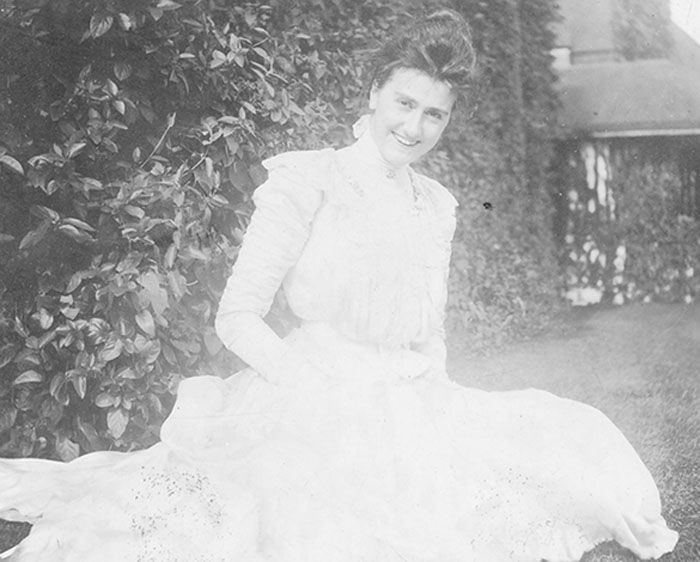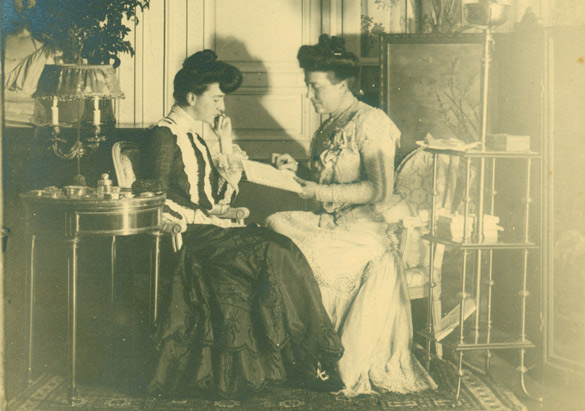Success in the classroom begins with a restful night’s sleep
 For all children and students, maintaining a regular bedtime schedule is important during the school year. More than 100 years ago, the importance of a sleep routine even applied during the childhood of the eventual hostess of the famed Biltmore House in Asheville, North Carolina, Edith Vanderbilt.
For all children and students, maintaining a regular bedtime schedule is important during the school year. More than 100 years ago, the importance of a sleep routine even applied during the childhood of the eventual hostess of the famed Biltmore House in Asheville, North Carolina, Edith Vanderbilt.
George Vanderbilt created a castle in the mountains of Western North Carolina in the late 1800s and then brought his bride, Edith Stuyvesant Dresser, to his treasure-filled home in 1898. Before this, however, Edith had grown up under the watchful eyes of her governess, Mademoiselle Marie Rambaud, while living with her grandmother in Newport, RI.
Edith’s grandmother was a member of high society, throwing many lavish parties at her New York and Newport homes. The memoirs of Pauline Dresser Merrill, Edith’s younger sister, recalls that she and Edith would climb out on the roof over their home’s dining room and look down at these parties through the skylights. With this in mind, it’s easy to imagine that there were probably nights when a young Edith would ask to stay up just a little longer. And who could blame her? She lived in one of the United States’ most fashionable neighborhoods, with her four siblings and an almost endless series of amusements close by. It was Marie Rambaud’s job to keep the girls in line though, and Edith’s governess understood the importance of a schedule to raising healthy, successful children. Once Edith snuggled into her luxurious bed and pulled up the covers, we can only imagine her efforts to stay awake would likely have given way to a delightful night’s sleep.
How much sleep should students get each night?
 Pauline Merill’s Reminiscences show that sufficient rest must have helped the four Dresser girls maintain strong academics and an active lifestyle.
Pauline Merill’s Reminiscences show that sufficient rest must have helped the four Dresser girls maintain strong academics and an active lifestyle.
Do your kids get the sleep they need to survive in school AND thrive in life?
The American Academy of Sleep Medicine offers these sleep guidelines for parents—the amount of sleep varies by a child’s age:
- 4-12 months: 14-17 hours
- 1-2 years: 12-14 hours
- 3-5 years: 10-13 hours
- 6-13 years: 9-11 hours
- 14-17 years: 8-10 hours
- 18+ years: 7+ hours
A variety of environments for Edith Dresser
Beginning at a young age, the five Dresser children—LeRoy, Natalie, Susan, Edith, and Pauline— split their time between stately Newport, RI, and the hustle and bustle of New York City. In New York, their time was less structured: Pauline recalls her sister’s roller skating in the basement hall of their home while she nestled atop folded laundry in the kitchen. Oh, and Edith raised 19 turtles in the back yard. In Newport, however, Edith’s grandparents were “living in the staid fashion of the Victorian era, dinner at three in the afternoon, the family silver immaculate, the habits of half a lifetime unbroken.” The girls were enrolled in a local elementary school to continue their education. When this school closed, their grandmother hired Marie Rambaud to pick up where they had left off.
 Life with their grandmother, however, was not all work and no play for the Dresser sisters. Edith found plenty amusements in Newport society, including co-ed dances, attended by children of good New York families. She would have had the opportunity to go horseback riding and carriage driving, pastimes she continued to enjoy during her time as hostess at Biltmore House. In the summer, Edith and her sisters would even walk to the beach three times a week. Of course, Rambaud accompanied the girls to make sure they kept to their schedule.
Life with their grandmother, however, was not all work and no play for the Dresser sisters. Edith found plenty amusements in Newport society, including co-ed dances, attended by children of good New York families. She would have had the opportunity to go horseback riding and carriage driving, pastimes she continued to enjoy during her time as hostess at Biltmore House. In the summer, Edith and her sisters would even walk to the beach three times a week. Of course, Rambaud accompanied the girls to make sure they kept to their schedule.
While living with their grandmother, the Dresser sisters were next door to the Newport Casino, a venue for outdoor sports and socializing. When they were young, Edith and Pauline would climb trees to watch the action at the Casino next door. When they were older, they attended dinners, dances, lawn games, and tennis and polo matches at the Casino. Edith Vanderbilt grew up in many different environments as a young child, which created the adaptable woman who came to reside over Biltmore House in 1898.
Evidence of a well-maintained routine
 Marie Rambaud maintained a strict schedule for her charges. It focused on exercise, education, and consistency. Pauline even commented, “There was no imagination in the daily routine and it varied little, summer or winter.” The girls awoke at 6:45 to the ringing of nearby church bells and stayed in bed until 7:00. They took forty-five minutes to dress, eat and spend a few moments outside before an hour of piano practice. Lessons were from 9:30-1:30 in the winter and 9:30-11:30 in the summer. They were encouraged to walk at least two hours every day. The Dresser sisters also took dancing lessons twice a week during the summer.
Marie Rambaud maintained a strict schedule for her charges. It focused on exercise, education, and consistency. Pauline even commented, “There was no imagination in the daily routine and it varied little, summer or winter.” The girls awoke at 6:45 to the ringing of nearby church bells and stayed in bed until 7:00. They took forty-five minutes to dress, eat and spend a few moments outside before an hour of piano practice. Lessons were from 9:30-1:30 in the winter and 9:30-11:30 in the summer. They were encouraged to walk at least two hours every day. The Dresser sisters also took dancing lessons twice a week during the summer.
Bedtime was an important part of this routine. Until they reached age 14, Edith and Pauline were required to be in bed at 6:15 in the evening, ensuring a full night’s sleep. As they grew, this was pushed back to 8:00 p.m. to allow them to spend more time with their family.
With such a strict schedule, each girl was encouraged to nurture her unique talents. Pauline proved adept at memorizing entire verses of poetry in both French and English, while Edith had a noted talent for mathematical calculations.
Edith’s childhood routines and experiences prepared her for an organized, well-disciplined life at Biltmore. With more than 250 rooms, which included 35 bedrooms, 43 bathrooms and 3 kitchens, the home also boasted the latest and greatest in technology. In the days when George, Edith, and Cornelia Vanderbilt resided at Biltmore, they employed up to 40 staff members who each played a crucial role in the day-to-day operations of the house and stable.
5 golden rules for establishing good sleep habits for children
 Do your children get enough sleep during the school year to excel academically and thrive physically? A study by the Better Sleep Council says many teenagers sacrifice sleep to get all of their homework done and then have trouble concentrating and comprehending new information the following day. The study revealed that an alarming 12% of teens get four hours of sleep or less on a regular school night.
Do your children get enough sleep during the school year to excel academically and thrive physically? A study by the Better Sleep Council says many teenagers sacrifice sleep to get all of their homework done and then have trouble concentrating and comprehending new information the following day. The study revealed that an alarming 12% of teens get four hours of sleep or less on a regular school night.
If your children are sacrificing their sleep for grades, it might be time to intervene. Parents can do a lot to shape sleep routines that their kids can follow throughout their lives, says Terry Cralle, registered nurse and certified clinical sleep educator. “It’s never too early to teach children about the importance of sleep. Good sleep habits will provide a lifetime of benefits.”
Researchers say it only takes three nights of insufficient sleep to make an adult or child feel and act as if legally intoxicated. Lack of sleep – both long and short term – can also impair memory and the ability to do simple tasks safely.
There are some basic – yet important – things a parent can do to set up their child for sleep success. Here are 5 golden rules for establishing good sleep habits for children, offered by the Better Sleep Council.
- Set a consistent bedtime. A regular bedtime strengthens circadian rhythms and helps ensure adequate time for sleep. “Kids will learn what to expect and bedtime will become a non-negotiable part of the day,” explains Cralle. “A regular bedtime also fosters healthy, independent sleep in children.” In one study, children without consistent bedtimes at age 3 had lower test scores in reading, math and spatial awareness at age 7 than children with regular bedtimes.
- Always put going to bed – and sleep in general – in a positive light. For example, parents should say: “You get to go to bed,” instead “You have to go to bed.” Reinforce to children that sleep is good for all of us. It helps them be better students, better athletes, better siblings, better friends – and it helps prevent them from becoming ill.
- Choose non-electronic, pre-sleep activities to encourage relaxation before bed. Electronics, especially in the bedroom, interfere with sleep, compromise sleep quality and encroach upon a child’s total sleep time. This is backed up by a study published in the medical journal Pediatrics. It said that screen time was associated with later sleep onset.
- Keep it clean. Just like adults, children will rest better in a sleep environment with minimal clutter. Encourage youngsters to keep their bedrooms tidy. Make sure that’s a clear path to avoid any nighttime falls or mishaps.
- Invest in high-quality, supportive mattress for your child. Allow older children to participate in their sleep health by getting involved in their mattress selection process. Use a mattress protector to minimize these allergens and keep the mattress cleaner.
Rest well & wake up ready to go!
Better sleep gives rise to better mornings, bringing your goals into focus and dreams within reach. Hungry for more sleep info? Dig into these posts:
Eager for more sleep info you can really use?
Join our community
Facebook
and let's continue the conversation.
We'd love to hear what you have to say!
This blog does not provide medical advice. It is intended for general informational purposes only and does not address individual circumstances. It is not a substitute for professional medical advice, diagnosis or treatment and should not be relied on to make decisions about your health. Never ignore professional medical advice in seeking treatment because of something you have read on Restonic.com. If you think you may have a medical emergency, immediately call your doctor or dial 911.

